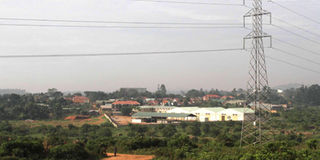Ten years on, Namanve yet to take off

A section of the Namanve Inustrial Park. Much of the Park’s land remains idle with only a few firms establishing structures and operations. PHOTO by Issac Kasamani.
What you need to know:
Ambitious plan? The government in 2002 launched an ambitious plan that would redirect Uganda from a peasant to an industrialised economy, however, 10 years down the road, there is less to suggest that this will soon be achieved.
In 2002, the government of Uganda launched an ambitious project that had promised to form the foundation for the turnaround of Uganda’s industrialisation.
The project that had been conceptualised around Namanve Industrial Park remains a shadow of its own self after the World Bank pulled out citing environmental concerns, administrative bureaucracy and inflated land costing procedures among others.
For more than a decade now there is little to suggest that Uganda Investment Authority would in the short term achieve its plan of forming an industrialised zone in the of east of Kampala (Namanve).
A simple walk through the Park brings out the reality of a failing project that has now been taken over by brick layers, food gatherers, mingling with cattle, sheep and goats that leisurely mow away on the Park’s fertile grass.
The Park, in its current form doesn’t emphasise President Museveni’s drive of turning Uganda into an industrialised economy by 2025.
In 2002 the government of Uganda signed a credit agreement with the World Bank that would jointly fund the establishment of an industrial park at Namanve at an estimated cost of Shs350 billion ($125m).
However, information obtained by Prosper indicates that the World Bank – a major funder of the project quit, citing fraudulent and unnecessary delays for the project’s implementation.
In an email, Mr Steven M. Shalita, the World Bank senior communications officer, told this newspaper that while it was prudent to launch the project, delays in actual implemention had in 2011 forced the bank to withdraw its financial support.
He said: “The Kampala Industrial Business Park (Namanve) could not be implemented due to delays related to environmental concerns and procurement.”
Thus, he adds, the government in consultation with it partners (World Bank) decided to cancel the sub-component.”
UIA statistics indicate that the government would at the moment need about Shs470 billion ($180 million) up from the budgeted Shs350 billion ($125m) to implement the project.
A survey conducted by Prosper also indicates that at least 80 per cent of the land that was allocated to businesses remains idle with no meaningful developments.
The Park, according to UIA, is divided into two wings including the southern and the northern wings.
The southern wing, which houses Hima Cement and Roofings among others has two interlinked murram roads with a poorly developed drainage system.
However, the southern wing is far better than the northern wing (that houses Coca Cola) that is devoid of even a properly developed foot path, has no electricity or water lines.
Whereas the southern wing was developed for large industries, the northern wing was developed to house small and medium industries.
This means that businesses that were allocated land in such areas (northern wing) cannot establish anything due to the absence of amenities including water, sewerage systems and electricity.
Ms Josephine Okot, the Victoria Seeds managing director, told Prosper that the biggest challenge is the lack of government’s commitment to provide basic infrastructure for the Park to operate.
“We can’t operate our business because we have no water and electricity supply or even access roads for big trucks. Additionally, the security of the entire Park is worrying considering that brick makers have transformed the Park into free land for collecting mud and burning bricks,” she says.
Accordingly, Ms Okot adds: “It seems as though UIA has failed to work on its mandate of offering serviced land and other ancillary services including street lighting, garbage collection and security.
“There is no basis for promoting Namanve as an Industrial park if individuals are expected to grade roads, provide electricity, water and security. The government must ensure that UIA is facilitated to implement its core mandate instead of embarrassing itself.”
A source who declined to be named told Prosper that at a recent meeting, an official from the government had suggested that they (investors) should dig boreholes that could provide them with water.
This he said was quite disturbing, unfortunate and irresponsible talk since they had been promised by the government that they would be provided with all amenities including water, electricity and access roads.
However, Eng Frank Sebowa, the UIA executive director, attributes the implementation lapses to not only low funding but the delay in receiving even the little that is allocated for the implementation of the project.
“We are working to fasten the development of Namanve and other parks. It is not an issue of commitment but an issue of funds. We even have a plan to have construct a basic road on the northern wing of the Park this financial year,” he says.
“For now, those who already set up workshops in Namanve should implement temporary interventions as we work to put in place permanent services.”
Far still, Dr Lawrence Bategeka, a senior research fellow at Makerere University says minus the absence of funds, there is need to probe the Namanve project in order to establish if land was allocated to genuine businesses.




